
NanoOrganic
manager@naturcosmet.ru
+7 (915) 330-35-96
+7 (915) 330-35-96
Крем для тела
Питает кожу, снимает раздражения, стимулирует обновление клеток кожи и повышает упругость.

Комплекс витаминов A, B5, C, E, F (5%)
замедляют старение кожи рук и тела.
Масла шиповника, арганы, конопли, ши, авокадо
интенсивно питают.
Натуральный пребиотик (2%)
восстанавливает защитный барьер.
Экстракты муира-пуамы, курильского чая и хвоща
повышают упругость и предотвращают возрастную пигментацию.
Состав
manager@naturcosmet.ru
+7 (915) 330-35-96
+7 (915) 330-35-96
Состав
вода (Aqua); экстракт хвоща полевого (Equisétum Arvénse Extract); экстракт муира-пуамы (Ptychopetalum Olacaceae Olacoides Extract); экстракт курильского чая (Pentaphylloides Fruticosa Extract); оливковое масло (Olea Europaea (Olive) Fruit Oil); масло конопли (Cannabis Sativa/Hemp Seed Oil); масло авокадо (Persea Gratissima (Avocado) Oil); эмульгатор из растительных масел* (Polyglyceryl-3 Methylglucose Distearate); провитамин B5 (Panthenol); масло ши (Butyrospermium Parkii (Shea) Butter); витамин F (Linoleic Acid, Linolenic Acid); пребиотик (Sorbitol); масло арганы (Argania Spinosa Kernel Oil); масло шиповника (Rosa Canina Fruit Oil); рапа морская (Rapan Salt); молочная кислота (Lactic Acid); натуральный витамин Е (Tocopherols Blend); янтарная кислота (Succinic Acid); витамин C (L-Ascorbic Acid); натуральные консерванты: экстракт розмарина, Nipaguard SCE* (Natural Preservatives: Rosmarinus Officinalis (Rosemary) Leaf Extract, Nipaguard SCE (Sorbitan Caprylate, Propanediol, Benzoic Acid); эфирное масло померанца (Citrus Aerantium Dulcis (Orange) Flower Oil); натуральные пищевые ароматизаторы (Natural Fragrance); витамин А (Retinol).
(*) разрешены европейскими системами экосертификации для органической косметики
(*) разрешены европейскими системами экосертификации для органической косметики
Разбор состава
Способ применения
Способ применения: нанести массирующими движениями на кожу тела, уделяя особое внимание сухим участкам.
Внимание: возможна индивидуальная непереносимость компонентов продукта.
Внимание: возможна индивидуальная непереносимость компонентов продукта.
Рекомендации
Наука
Исследования
Ниже можно посмотреть некоторые научные статьи, подтверждающие эффективность используемых активов. Слово "Источник" является активной ссылкой, перенаправляющей на первоисточник на платформе PubMed (общемировая платформа научных статей по медицине, биохимии, биологии) или других научных ресурсах.
Мурашкин Н. Н. и др. Инновации в терапии атопического дерматита, осложненного вторичной инфекцией //Педиатрическая фармакология. – 2018. – Т. 15. – №. 4.
Yang M., Zhou M., Song L. A review of fatty acids influencing skin condition //Journal of cosmetic dermatology. – 2020. – Т. 19. – №. 12. – С. 3199-3204.
Spagnol C. M. et al. Ascorbic acid in cosmetic formulations: Stability, in vitro release, and permeation using a rapid, inexpensive, and simple method //Journal of Dispersion Science and Technology. – 2017. – Т. 38. – №. 6. – С. 901-908.
Ravetti S. et al. Ascorbic acid in skin health //Cosmetics. – 2019. – Т. 6. – №. 4. – С. 58.
Ehrlich M. et al. Improvement in the Appearance of Wrinkles with Topical Transforming Growth Factor β1 and l‐Ascorbic Acid //Dermatologic surgery. – 2006. – Т. 32. – №. 5. – С. 618-625.
Trommer H. et al. Role of ascorbic acid in stratum corneum lipid models exposed to UV irradiation //Pharmaceutical research. – 2002. – Т. 19. – №. 7. – С. 982-990.
Kim S., Lee T. G. Stabilization of l-ascorbic acid in cosmetic emulsions //Journal of industrial and engineering chemistry. – 2018. – Т. 57. – С. 193-198.
Raschke T. et al. Topical activity of ascorbic acid: from in vitro optimization to in vivo efficacy //Skin pharmacology and physiology. – 2004. – Т. 17. – №. 4. – С. 200-206.
Stettler H. et al. A new topical panthenol-containing emollient: Results from two randomized controlled studies assessing its skin moisturization and barrier restoration potential, and the effect on skin microflora
Journal of Dermatological Treatment. – 2017. – Т. 28. – №. 2. – С. 173-180.
Journal of Dermatological Treatment. – 2017. – Т. 28. – №. 2. – С. 173-180.
Bissett D. L. Common cosmeceuticals
Clinics in dermatology. – 2009. – Т. 27. – №. 5. – С. 435-445.
Clinics in dermatology. – 2009. – Т. 27. – №. 5. – С. 435-445.
Pavlačková J. et al. In vivo efficacy and properties of semisolid formulations containing panthenol
Journal of cosmetic dermatology. – 2019. – Т. 18. – №. 1. – С. 346-354.
Journal of cosmetic dermatology. – 2019. – Т. 18. – №. 1. – С. 346-354.
Yoshioka A. et al. Anti-oxidant effects of retinoids on inflammatory skin diseases //Archives of dermatological research. – 1986. – Т. 278. – №. 3. – С. 177-183.
Zasada M., Budzisz E. Retinoids: Active molecules influencing skin structure formation in cosmetic and dermatological treatments //Advances in Dermatology and Allergology/Postȩpy Dermatologii i Alergologii. – 2019. – Т. 36. – №. 4. – С. 392.
Słoczyńska K. et al. Skin metabolism established with the use of MetaSite for selected retinoids employed in topical and systemic treatment of various skin disorders and found in cosmeceuticals //Acta Biochimica Polonica. – 2015. – Т. 62. – №. 2.
Ramos-e-Silva M. et al. Anti-aging cosmetics: Facts and controversies //Clinics in dermatology. – 2013. – Т. 31. – №. 6. – С. 750-758.
Packer L., Valacchi G. Antioxidants and the response of skin to oxidative stress: vitamin E as a key indicator //Skin Pharmacology and Physiology. – 2002. – Т. 15. – №. 5. – С. 282-290.
Nachbar F., Korting H. C. The role of vitamin E in normal and damaged skin //Journal of Molecular Medicine. – 1995. – Т. 73. – №. 1. – С. 7-17.
Thiele J. J., Ekanayake-Mudiyanselage S. Vitamin E in human skin: organ-specific physiology and considerations for its use in dermatology //Molecular aspects of medicine. – 2007. – Т. 28. – №. 5-6. – С. 646-667.
El Abbassi A. et al. Physicochemical characteristics, nutritional properties, and health benefits of argan oil: A review //Critical reviews in food science and nutrition. – 2014. – Т. 54. – №. 11. – С. 1401-1414.
El Abbassi A. et al. Physicochemical characteristics, nutritional properties, and health benefits of argan oil: A review //Critical reviews in food science and nutrition. – 2014. – Т. 54. – №. 11. – С. 1401-1414.
Pavlačková J. et al. Stability and in vivo efficiency of natural cosmetic emulsion systems with the addition of vegetable oils //Brazilian Journal of Pharmaceutical Sciences. – 2018. – Т. 54.
Kanlayavattanakul M., Lourith N. An update on cutaneous aging treatment using herbs //Journal of Cosmetic and Laser Therapy. – 2015. – Т. 17. – №. 6. – С. 343-352.
Eberlin S. et al. Effects of a Brazilian herbal compound as a cosmetic eyecare for periorbital hyperchromia ("dark circles") //Journal of cosmetic dermatology. – 2009. – Т. 8. – №. 2. – С. 127-135.
Oktyabrsky O. et al. Assessment of anti‐oxidant activity of plant extracts using microbial test systems //Journal of Applied Microbiology. – 2009. – Т. 106. – №. 4. – С. 1175-1183.
Luo Z., Wang S., Wang D. Phenolic profiles and antioxidant capacities of crude extracts and subsequent fractions from Potentilla fruticosa L. leaves //Natural product research. – 2016. – Т. 30. – №. 16. – С. 1890-1895.
Miliauskas G., Venskutonis P. R., Van Beek T. A. Screening of radical scavenging activity of some medicinal and aromatic plant extracts //Food chemistry. – 2004. – Т. 85. – №. 2. – С. 231-237.
